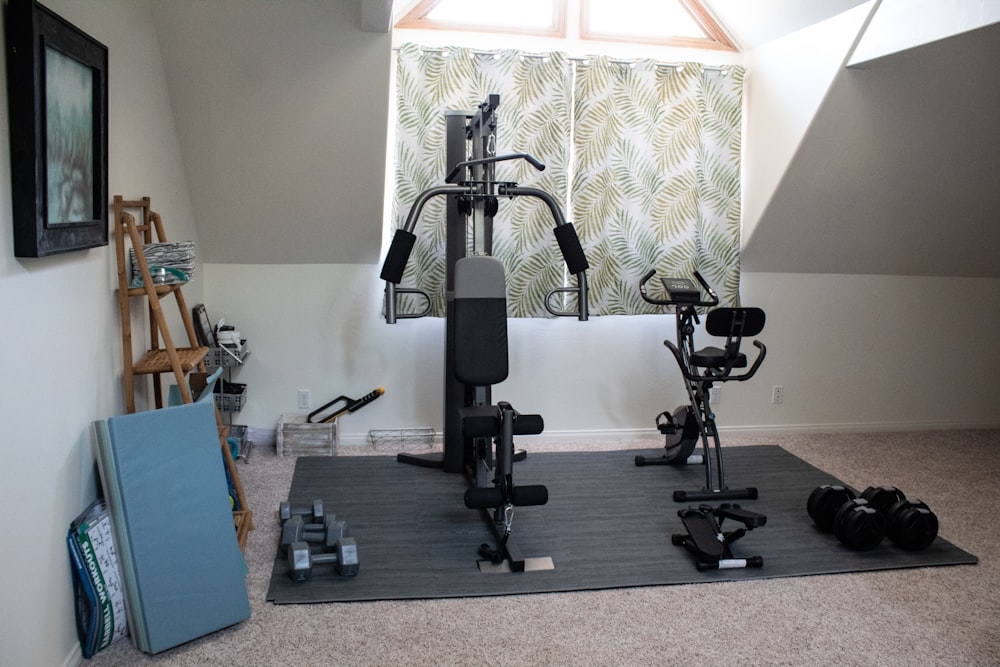Building a Home Workout Routine
In recent times, many people have opted to workout from the comfort of their homes, and it's easy to see why. Home workouts are convenient, cost-effective, and can be customized to fit your unique needs and preferences. However, building a home workout routine can be challenging, especially for beginners.
Image credits: Brian Wangenheim
In this blog post, we'll explore some tips and tricks to help you build an effective home workout routine.
Determine Your Fitness Goals
The first step in building a home workout routine is to determine your fitness goals. Do you want to lose weight, build muscle, improve your cardiovascular endurance, or all of the above? Knowing your fitness goals will help you determine the type of exercises you need to include in your workout routine. For example, if your goal is to lose weight, you'll want to focus on exercises that burn calories, such as high-intensity interval training (HIIT) and cardio.
Create a Workout Schedule
Once you've determined your fitness goals, it's time to create a workout schedule. It's essential to set aside time in your day for exercise and stick to it. Consistency is key to achieving your fitness goals. Ideally, you should aim for at least 30 minutes of exercise per day, five days a week. However, if you're just starting, it's okay to start with shorter workouts and gradually increase the duration as you build your fitness level.
Choose Your Exercises
When building a home workout routine, you have a wide range of exercises to choose from, including bodyweight exercises, dumbbell exercises, resistance band exercises, and yoga. It's important to choose exercises that target different muscle groups and work towards your fitness goals.
Here are some exercises you can include in your home workout routine:
Bodyweight Exercises:
- Push-ups
- Squats
- Lunges
- Plank
- Burpees
- Mountain Climbers
- Jumping Jacks
- High Knees
- Butt Kicks
- Crunches
Dumbbell Exercises:
- Bicep Curls
- Shoulder Press
- Tricep Extensions
- Chest Fly
- Bent-Over Row
- Goblet Squat
- Romanian Deadlift
- Lateral Raises
- Hammer Curls
Resistance Band Exercises:
- Bicep Curls
- Tricep Extensions
- Lat Pull-Downs
- Leg Press
- Squats
- Deadlifts
- Chest Press
- Standing Rows
Yoga:
- Downward-Facing Dog
- Child's Pose
- Warrior I, II, III
- Tree Pose
- Cat-Cow Pose
- Cobra Pose
- Bridge Pose
- Seated Forward Fold
- Pigeon Pose
Warm-up and Cool-down
Warming up before a workout is crucial to prevent injury and prepare your body for exercise. A proper warm-up should last for five to ten minutes and include light cardio and stretching. Examples of warm-up exercises include jogging in place, jumping jacks, and leg swings.
Similarly, cooling down after a workout is just as important as warming up. A cool-down should last for five to ten minutes and include light cardio and stretching. Examples of cool-down exercises include walking, jogging in place, and static stretching.
Progression and Variation
To continue seeing results and avoid boredom, it's essential to vary your workouts and increase the intensity gradually. For example, you can increase the number of repetitions, sets, or weights as you get stronger. You can also switch up your workout routine by trying new exercises or adding different types of workouts, such as yoga or Pilates.
Track Your Progress
Tracking your progress is an excellent way to stay motivated and see how far you've come. You can track your progress by keeping a workout journal or using a fitness app that tracks your workouts and progress. This will help you identify areas that need improvement and set realistic goals for yourself.
Stay Hydrated and Nourished
Staying hydrated and nourished is essential for any workout routine. Make sure to drink plenty of water before, during, and after your workout to prevent dehydration. Additionally, it's essential to fuel your body with healthy foods to provide the energy it needs to perform during your workout. Incorporating a balanced diet that includes plenty of fruits, vegetables, whole grains, and lean proteins can help support your workout routine and overall health.
Set Realistic Goals
Setting realistic goals is crucial for building a sustainable home workout routine. While it's important to challenge yourself, setting unattainable goals can lead to frustration and disappointment. Start with small goals and gradually work your way up as you progress.
Get Creative with Your Environment
One of the benefits of a home workout routine is the flexibility to customize your workout environment. You can get creative with your surroundings by using household items as workout equipment, such as using a chair for tricep dips or a backpack filled with books for weighted squats. You can also take your workout outside or try a virtual workout class for a change of scenery.
Don't Be Afraid to Ask for Help
Building a home workout routine can be challenging, especially for beginners. Don't be afraid to ask for help if you're unsure about exercises or need guidance. You can seek advice from a personal trainer, online fitness community, or even a friend who has experience with home workouts.
In conclusion, building a home workout routine requires discipline, consistency, and creativity. By following these tips and incorporating them into your workout routine, you can build an effective and sustainable home workout routine that supports your fitness goals and overall health. Remember to stay hydrated, nourished, and don't be afraid to ask for help along the way.

Comments
Post a Comment